Crossing Paths
How sex tourism, intravenous drug use and a highly mobile population has created a formidable HIV/AIDS epidemic in Tijuana, MX
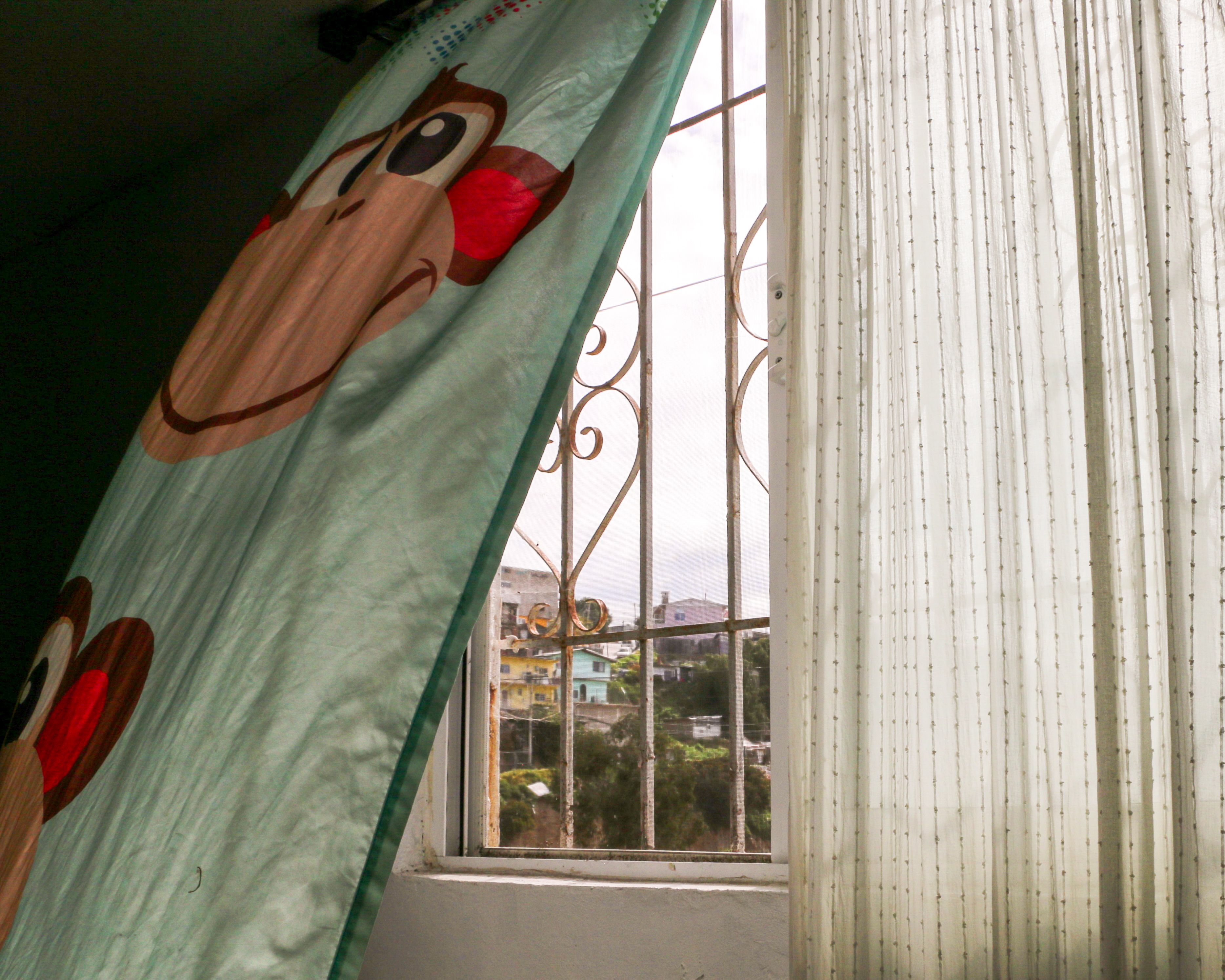
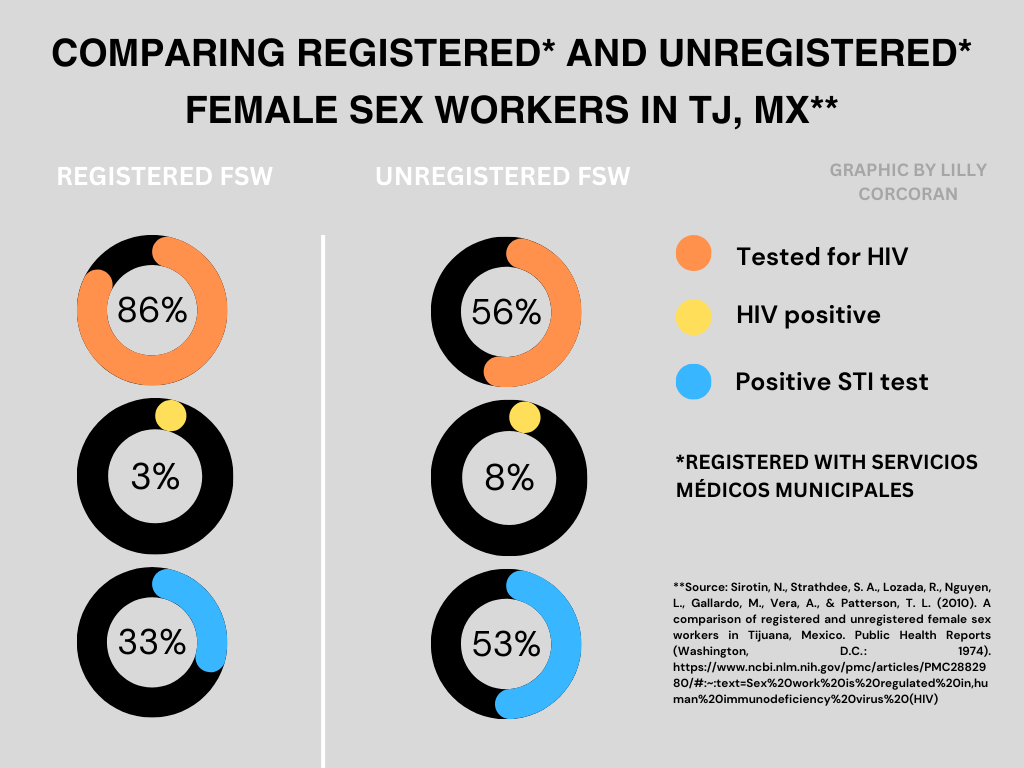

The global incidence rate of HIV has decreased by over a third since 2019, and over half since the epidemic peak in 1995.¹ Even the number of San Diego County residents diagnosed with HIV has dropped, the incidence rate being less than half of what it was from 1993 to 2018.² Why is it that just 20 miles south of San Diego lies such a staggeringly high incidence rate of HIV within at-risk groups as compared to those same at-risk groups in San Diego?
The second largest city in Mexico, Tijuana, is situated on the US Mexico border.³ Home to the San Ysidro port of entry, an estimated 150,000 people cross either way daily and over 46 million northbound crossings occur yearly.⁴⁺⁵ Over half of Tijuana’s residents are migrants, however the majority of residents were born in Mexico.⁵⁺⁶
The incidence rate of HIV+ people is about the same in Tijuana as it is in the United States.⁷ Mexico is considered to be “low prevalence, high risk” in regards to HIV, and the distribution of the infection varies by location.⁸ The difference lies when looking at the rates within at-risk communities, concentrations of HIV in Tijuana overlap in some groups such as intravenous drug users, female sex workers, their clientele and male sex workers.⁷⁺⁹
While sex workers must obtain a permit from Servicios Médicos Municipales, many don't, which has led to a slight uptick in HIV+ female sex workers.
Within Zona Roja, an approved red light district area in Tijuana, drugs and prostitution run rampant. While sex workers must obtain a permit from Servicios Médicos Municipales, many don't, which has led to a slight uptick in HIV+ female sex workers.⁹⁺⁵⁺¹⁰ However, overall Tijuana has been narrowing the gap in the number of men and women that have HIV.¹¹ This could be in part due to the social stigma surrounding the LGBTQ+ community, “straight” men unknowingly passing the infection to their wives after utilizing the services of homosexual male sex workers.¹¹
At a 2022 conference, University of California San Diego researchers presented data surrounding a recent HIV outbreak in Tijuana. Caused in part by international drug tourism, it was not inhibited by the border closure due to COVID-19. They found the HIV incidence rate among Tijuana drug users had jumped to an unheard of 11%. The rate for San Diego drug users that crossed the border in pursuit of purchasing drugs was 2.77%, but this was still higher than the incidence rate of San Diego drug users that do not cross the border for drugs. This group's incidence rate was 0%.¹² From 2020 to 2021 the number of HIV/AIDS cases in the state of Baja California had risen 106%, suggesting a direct correlation with the COVID-19 pandemic.¹³
HIV incidence rates in Tijuana had been slowly waning, in some measure due to an effort by the Global Fund for HIV to create more widely available resources for the general public and at-risk groups. Funding and governmental support was slowly reduced, and the genesis of COVID-19 meant there was even less money and resources to allocate to prevention and outreach.¹²
Unregulated sex work, intravenous drug use and a highly mobile population have allowed the problem to compound. An outreach program started by the Federal Ministry of Health hoped to educate and assist at-risk communities. Condonetasare vans provide resources like rapid HIV tests, new needles and condoms to neighborhoods that are considered high risk for HIV transmission. They are decorated with caricature condoms in an effort to break the stigma and conservatism surrounding sex and sex education in Mexico. ¹¹⁺¹⁴
“Within Tijuana at large, people really aren’t very well informed about HIV at all.”
Photographer Malcolm Linton and journalist Jon Cohen followed this beat closely for their book “Tomorrow Is a Long Time: Tijuana's Unchecked HIV/AIDS Epidemic.” When interviewed for Mother Jones Magazine Cohen stated, “There’s no coordinated, aggressive testing program or outreach program… If you are infected in San Diego and attend a good clinic, the people who care for you will closely monitor how you’re doing… If you don’t show up for an appointment, an outreach worker may contact you… None of this exists in Tijuana.”⁷ Linton stated, “Within Tijuana at large, people really aren’t very well informed about HIV at all.”⁷
Antiretroviral therapy (ART) drugs are available for free in Mexico to those eligible via health care, however the system struggles to meet the demand and incorrect regimens being prescribed hampers the ability for widespread change.¹¹⁺¹⁵ When interviewed for the Border Report, Edoardo Rodríguez, assistant director of Tijuana’s office of diversity and inclusion, agreed. Rodríguez stated, “The state’s health care system needs to adopt a program, it can’t be just one site where people can get tested, we need more sites to accommodate everyone.”¹⁶
Sources on bottom of page.
Since the first reporting of the HIV/AIDS epidemic in 1981, the infection has been misunderstood, misrepresented and highly stigmatized.⁹⁺¹⁰ Untrue and harmful HIV/AIDS stereotypes are commonplace in society, leading to the perpetuation of outcasting groups such as the LGBTQ+ community.¹⁰ Even though there is not a cure, our understanding of HIV/AIDS changes every day as new research and treatment options become available.²
Simply put, HIV (human immunodeficiency virus) attacks infection fighting cells, making a person more susceptible to other diseases and infections.¹ If untreated, it can develop into AIDS (acquired immunodeficiency syndrome).¹ Not everyone who has HIV will get AIDS, but it is a common development if HIV is left untreated.² Typically those with AIDS either did not get a formal diagnosis or did not begin treatment in time to stop the infection from evolving further.²
HIV symptoms are flu-like, including fever, headaches and fatigue.² When the inflection becomes AIDS the symptoms become more severe, including sudden weight loss, mouth/anal/gential sores, pneumonia and depression.²
HIV is spread through contact with bodily fluids such as blood, semen, vaginal fluid and breast milk; typically contracted through sex, shared needles, or perinatal (mother to baby) transmission.² HIV can be prevented by practicing safe sex or being abstinent and not sharing needles.³
Perinatal transmission can happen at many points during and after pregnancy. This includes pregnancy, birth or breastfeeding.⁴ However an HIV+ person will not necessarily have an HIV+ baby.⁴ Use of medication like antiretroviral therapy, cesarean delivery dependent on viral load and safe breastfeeding have helped bring vertical transmission down to ≤1% in the United States and Europe.⁴
Testing for HIV can be done in three ways: antibody tests, antigen/antibody tests and NATs.⁵ You can get a definite answer to your status, however no test can immediately detect infection after transmission.⁵
While there is not currently a cure for HIV/AIDS, there are over 30 antiretroviral therapy (ART) drugs that are used to help those living with the condition.² ART drugs stop the HIV cells from duplicating, helping reduce symptoms, lowering viral load and reducing the risk of infecting others.² The goal is to get the viral load to an undetectable level and maintain that status.²
Once the viral load has maintained an undetectable level for 6 months, you can no longer sexually transmit HIV.⁶ With treatment, it is very possible for an HIV+ person to live a relatively normal life and maintain a normal life span.² While there is not a cure, AIDS related deaths have shrunk by 69% since a peak in 2004 and with public education, the implementation of ART drugs and preventative drugs like PrEP, the diagnosis is no longer the death sentence it once was.⁷⁺⁸
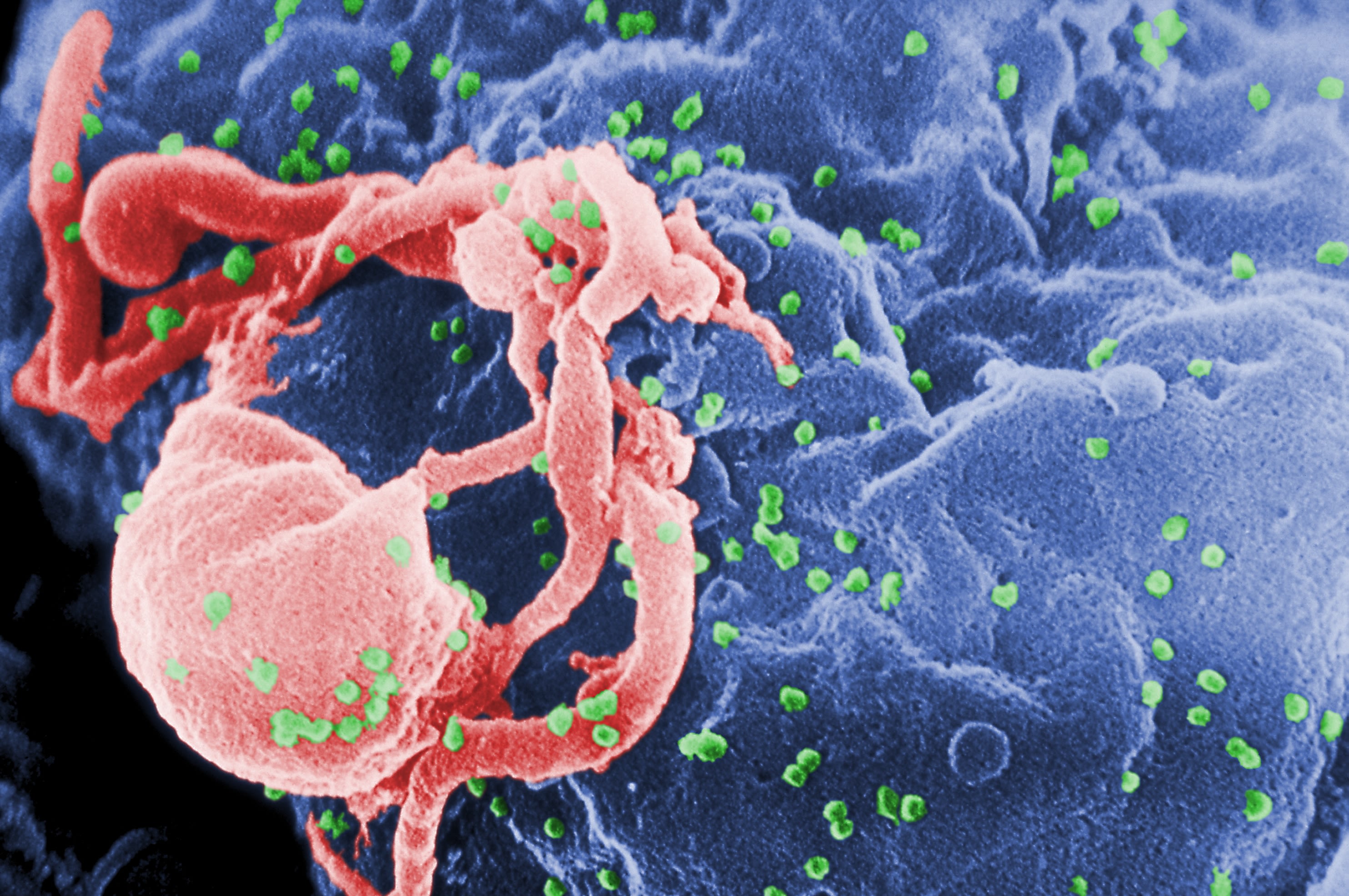
HIV (in green) germinating from lymphocyte. Photo credit to Wikipedia.
HIV (in green) germinating from lymphocyte. Photo credit to Wikipedia.
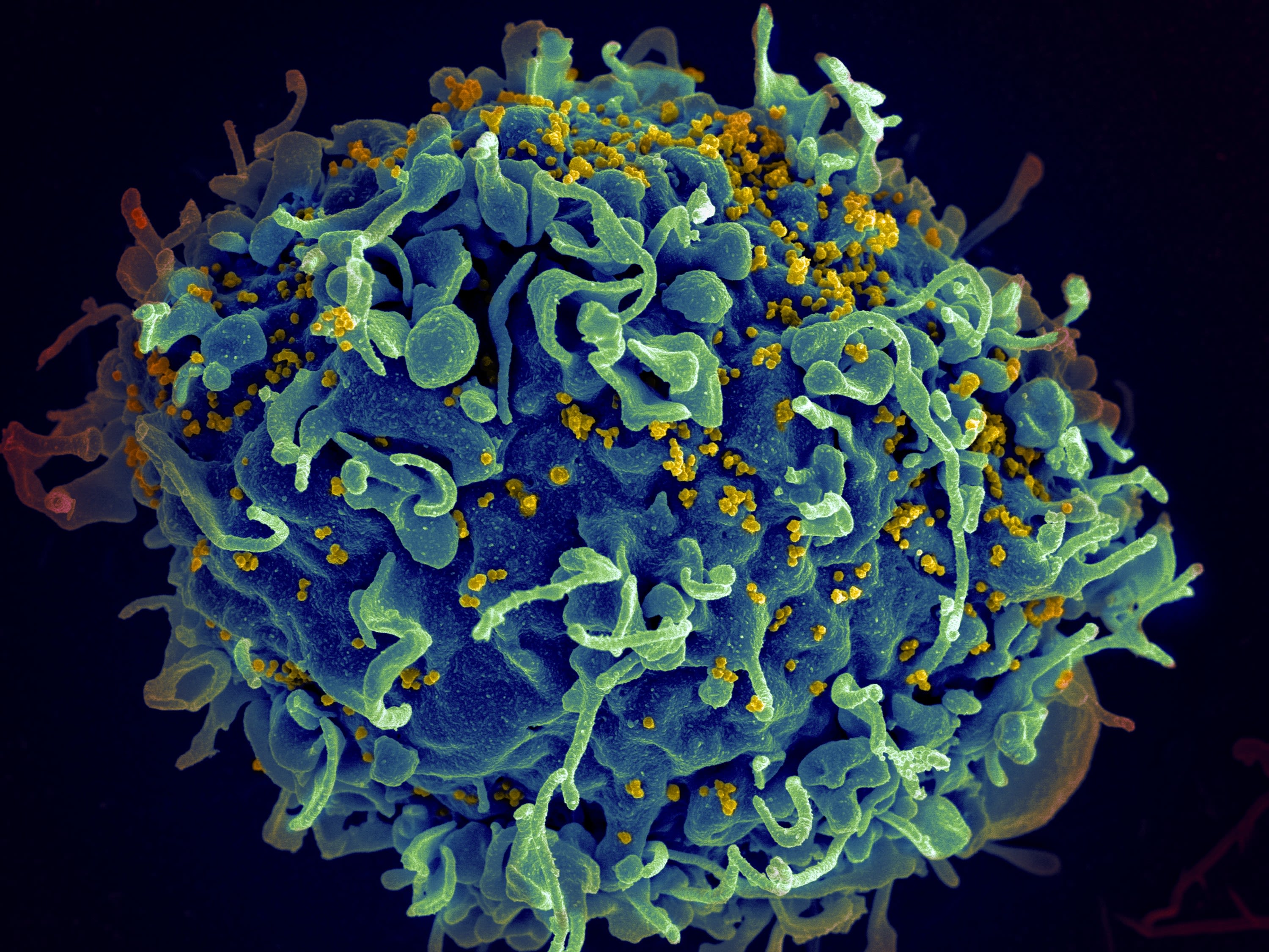
AIDS virus (yellow) infecting cell. Photo credit to National Institute of Allergy and Infectious Diseases, National Institutes of Health.
AIDS virus (yellow) infecting cell. Photo credit to National Institute of Allergy and Infectious Diseases, National Institutes of Health.
Citations
1. What are HIV and AIDS? HIV.gov. January 13, 2023. Accessed March 12, 2024. https://www.hiv.gov/hiv-basics/overview/about-hiv-and-aids/what-are-hiv-and-aids.
2. HIV vs. AIDS: Differences and progression. WebMD. May 21, 2023. Accessed March 12, 2024. https://www.webmd.com/hiv-aids/hiv-aids-difference#:~:text=HIV%20is%20a%20virus.,get%20treatment%20with%20antiretroviral%20drugs.
3. HIV prevention. HIV prevention | Office on Women’s Health. Accessed March 12, 2024. https://www.womenshealth.gov/hiv-and-aids/hiv-prevention.
4. Preventing perinatal transmission of HIV. National Institutes of Health. July 26, 2023. Accessed March 12, 2024. https://hivinfo.nih.gov/understanding-hiv/fact-sheets/preventing-perinatal-transmission-hiv#:~:text=transmission%20of%20HIV%3F-,Perinatal%20transmission%20of%20HIV%20is%20when%20HIV%20is%20passed%20from,and%20vertical%20transmission%20of%20HIV.
5. HIV testing. Centers for Disease Control and Prevention. June 9, 2022. Accessed March 12, 2024. https://www.cdc.gov/hiv/testing/index.html.
6. Wilberg M. I’m living with HIV. can I have sex without a condom? aidsmap.com. December 1, 2023. Accessed March 12, 2024. https://www.aidsmap.com/about-hiv/faq/im-living-hiv-can-i-have-sex-without-condom#:~:text=Once%20your%20viral%20load%20has,to%20your%20partner(s).
7. Global HIV & AIDS statistics - fact sheet. UNAIDS. Accessed March 12, 2024. https://www.unaids.org/en/resources/fact-sheet.
8. Descovy for prep® (pre-exposure prophylaxis). DESCOVY for PrEP® (pre-exposure prophylaxis). Accessed March 12, 2024. https://www.descovy.com/.
9. Timeline of the HIV and AIDS epidemic. HIV.gov. Accessed March 12, 2024. https://www.hiv.gov/hiv-basics/overview/history/hiv-and-aids-timeline#year-1981.
10. Debunking common myths about HIV. Human Rights Campaign. January 2023. Accessed March 12, 2024. https://www.hrc.org/resources/debunking-common-myths-about-hiv.
With treatment, it is very possible for an HIV+ person to live a relatively normal life and maintain a normal life span.
Eunime por Tijuana Photo Essay: https://www.lillycorcoran.com/portfolio/eunimephotoessay
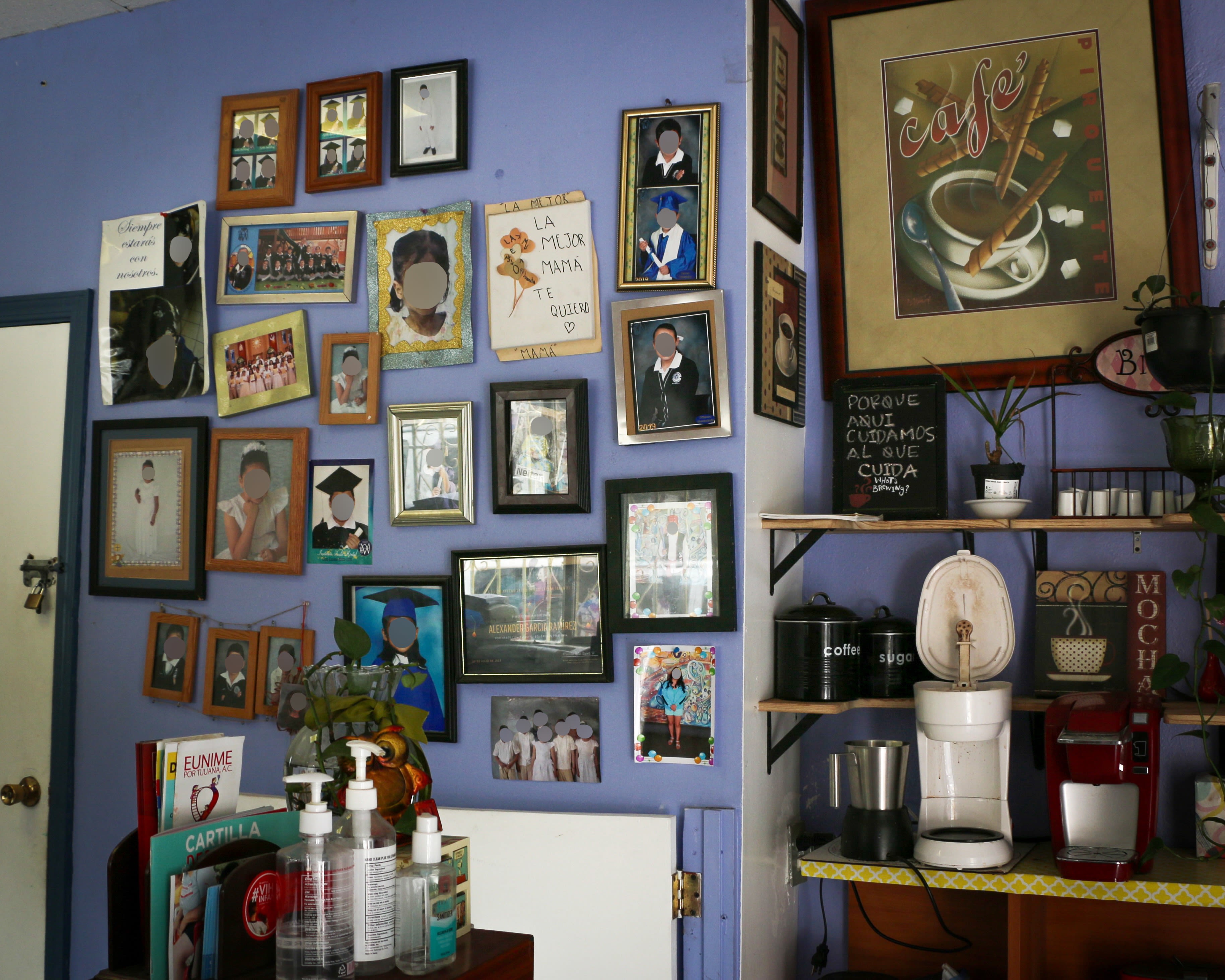
Citations for An Epidemic in Tijuana
1. HIV and AIDS epidemic global statistics. HIV.gov. Accessed March 13, 2024. https://www.hiv.gov/hiv-basics/overview/data-and-trends/global-statistics#:~:text=New%20HIV%20Infections—An%20estimated,since%20the%20peak%20in%201995.
2. Monthly communicable disease report - county of San Diego. Accessed March 13, 2024. https://www.sandiegocounty.gov/content/dam/sdc/hhsa/programs/phs/documents/Monthly_CD_Report_September2019.pdf.
3. O’Neill A. Mexico - largest cities 2020. Statista. February 2, 2024. Accessed March 13, 2024. https://www.statista.com/statistics/275435/largest-cities-in-mexico/.
4. Vital pedestrian crossing reopens at San Diego border. Spectrum News. Accessed March 13, 2024. https://spectrumnews1.com/ca/la-west/transportation/2024/01/04/vital-pedestrian-crossing-reopens-at-san-diego-border#:~:text=Joaquin%20Luken%20is%20the%20executive,and%20work%20in%20San%20Diego.
5. Sirotin N, Strathdee SA, Lozada R, et al. A comparison of registered and unregistered female sex workers in Tijuana, Mexico. Public health reports (Washington, D.C. : 1974). 2010. Accessed March 13, 2024. https://www.ncbi.nlm.nih.gov/pmc/articles/PMC2882980/#:~:text=Sex%20work%20is%20regulated%20in,human%20immunodeficiency%20virus%20(HIV).
6. Tijuana population 2024. Accessed March 13, 2024. https://worldpopulationreview.com/world-cities/tijuana-population.
7. Pauly M. These stark photos reveal a hidden battlefront in the war on AIDS. Mother Jones. December 1, 2015. Accessed March 13, 2024. https://www.motherjones.com/media/2015/12/tomorrow-long-time-tijuana-hiv-aids-epidemic/.
8. Brouwer KC, Strathdee SA, Magis-Rodríguez C, et al. Estimated numbers of men and women infected with HIV/AIDS in Tijuana, Mexico. Journal of urban health : bulletin of the New York Academy of Medicine. March 2006. Accessed March 13, 2024. https://www.ncbi.nlm.nih.gov/pmc/articles/PMC2527171/#:~:text=The%20majority%20of%20these%20persons,in%20Tijuana%20is%20HIV%2Dinfected.
9. Fraser H, Borquez A, Stone J, et al. Overlapping key populations and HIV transmission in Tijuana, Mexico: A modelling analysis of epidemic drivers. AIDS and behavior. November 2021. Accessed March 13, 2024. https://www.ncbi.nlm.nih.gov/pmc/articles/PMC8560668/.
10. Zona Norte, Tijuana. Wikipedia. February 3, 2024. Accessed March 13, 2024. https://en.wikipedia.org/wiki/Zona_Norte,_Tijuana#:~:text=Prostitution%20is%20permitted%20in%20Tijuana%27s,subjected%20to%20monthly%20health%20checkups.
11. Strathdee SA. Mexico’s Evolving HIV Epidemic. JAMA. 2008;300(5):571. doi:https://doi.org/10.1001/jama.300.5.571
12. Researchers find unprecedented rise in HIV incidence rate among people who inject drugs in Tijuana. News-Medical. Published February 12, 2022. Accessed March 13, 2024. https://www.news-medical.net/news/20220212/Researchers-find-unprecedented-rise-in-HIV-incidence-rate-among-people-who-inject-drugs-in-Tijuana.aspx
13. AIDS and HIV cases double in Baja California. BorderReport. Published December 1, 2021. Accessed March 13, 2024. https://www.borderreport.com/regions/california/aids-and-hiv-cases-double-in-baja-california/#:~:text=TIJUANA%20(Border%20Report)%20
14. Mexico Hoping to Drive Down HIV/AIDS with Prevention Program. www.banderasnews.com. Accessed March 13, 2024. http://www.banderasnews.com/0710/hb-condoneta.htm
15. Bautista-Arredondo S, Mane A, Bertozzi SM. Economic impact of antiretroviral therapy prescription decisions in the context of rapid scaling-up of access to treatment: lessons from Mexico. AIDS. 2006;20(1):101-109. doi:https://doi.org/10.1097/01.aids.0000198096.08444.53
16. Health care system for people battling HIV sought in Tijuana. BorderReport. Published December 1, 2023. Accessed March 13, 2024. https://www.borderreport.com/news/top-stories/health-care-system-for-people-battling-hiv-sought-in-tijuana/
